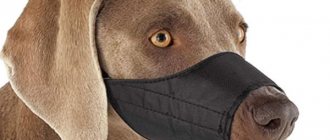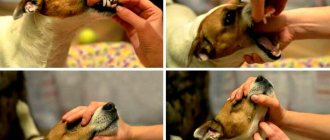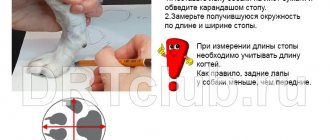Very few owners know how to inject a dog into the withers. Most people prefer to contact veterinarians, not taking into account 2 big disadvantages: high risk in case of force majeure and severe stress for the animal.
This seems strange, but the loss of time and money is far from the main thing here. Without knowing the basic nuances, you will never be able to help your pet in an emergency. For this reason, be sure to try to remember the rules and procedure for performing a subcutaneous injection - the simplest type, accessible even to a beginner.
In what cases is the injection given?
When a disease is detected, veterinarians often prescribe intramuscular injections. After all, these procedures allow you to inject a solution into soft tissues, from where it enters the blood in a matter of seconds. In addition, the medicine does not come into contact with the walls of the gastrointestinal tract, which is important for diseases of the digestive system.
The ability to give an injection to your dog (intramuscularly, subcutaneously) may be required if:
- the need to immediately administer the medicine;
- inability to contact a veterinarian;
- long course of treatment.
Remember, some injections can only be administered by a veterinarian. For example, home vaccination is not recognized by health authorities. The vaccine must be administered in the clinic and confirmed by a signature and stamp on the veterinary passport.
Complications after an incorrectly placed injection
Soreness, lameness after injection
Depending on the animal’s temperament, as well as its acting qualities, the administration of any medicine can cause a storm of negative emotions. There is no need to be afraid of this. This most likely has nothing to do with getting into the wrong place.
There are drugs that irritate tissues and cause discomfort. The pain after the injection will go away on its own within 1 hour after administration of the medicine.
Blood after injection
Any injection is a microtrauma, no matter how correctly you inject your dog. Ignore small amounts of blood. If there is a lot of blood, apply local cold for 10 minutes to stop the bleeding. If this doesn't help, contact your veterinarian.
The dog presses its paw
This could be from irritating medications. Don't worry, it will pass. It is dangerous if the paw drags like a whip. This may indicate that the needle got deeper into the muscles, into the nerve bundle. In this case, contact a veterinary clinic.
Post-injection abscesses
If hygiene measures are not observed or the medication is administered incorrectly, an abscess may form. This is a pathological cavity filled with pus. As a rule, the injection site is painful and hot. This complication requires immediate contact with a veterinarian.
Post-injection sarcoma
In some cases, after the administration of drugs, a tumor may form at the injection site. No one is immune from this, even a veterinarian with extensive experience.
Most often, this complication is associated with the administration of biological drugs (vaccines, serums). In this case, surgical removal of the swelling is required.
Preparing and restraining the dog
Before the injection, you need to prepare a syringe and medicine, and think through your actions. Fussiness and excitement frighten the dog, causing its muscles to tense. When an animal is in this state, it is more difficult for a person to insert a needle or squeeze the syringe plunger. In addition, the risk of complications after the injection increases.
The best time for injections is after a walk and eating. During this period, the animal is calm and relaxed. But some injections are given only before meals or at certain times of the day. In this case, you must act strictly according to the instructions.
Intramuscular injection, even in a small dog, requires secure fixation. For dwarf decorative breeds, bags are sold in which it is convenient to immobilize the pet with only one leg out. The animal can also be restrained by wrapping it in a large terry towel.
The mouth of a medium to large dog is always secured with a muzzle or an elastic bandage. Next, the assistant holds the pet's head and pinches its body with its legs. Another way is to tie the animal by the collar to any stable object.
General staging rules
When administering injections of any type, it is necessary to take into account some general rules.
- It is not advisable to wipe the skin of an animal with alcohol-containing compounds - it has an antibacterial coating.
- The medicine should be at room temperature. If the solution is oily, it can be slightly heated. You can hold the ampoule with an aqueous solution in your hands for a while.
- The skin on the withers at the injection site should be clean and free of damage.
- Before making a subcutaneous injection, you need to choose the right angle and take the syringe so that it is convenient to carry out the manipulation.
Intramuscular injection in the thigh
Injecting the drug into the muscle allows you to quickly deliver the medicine to the diseased organ and avoid irritation of the walls of the digestive system. Therefore, such procedures are prescribed when long-term course treatment of serious animal diseases is necessary.
Step-by-step instructions allow you to correctly and quickly inject the medicine into a dog’s muscle.
Selecting a syringe
The insulin syringe is suitable for injections in puppies and miniature breed dogs. Its thin needle easily and almost imperceptibly enters the muscle tissue.
Injection with an insulin syringe is prohibited when injecting a solution with sediment or oily consistency. Such liquid can clog the narrow hole of the needle.
The 2 ml syringe is equipped with a thin needle that can reach the muscle layer of a medium-sized dog. Therefore, when prescribing 3-5 ml of medication, you can transfer it to a larger volume instrument.
A 5-ml syringe is used to administer the medicinal solution to large and giant breed dogs. Its long needle reaches the deep muscle layers and distributes the drug evenly.
We collect medicine
Examine the ampoule. The name and expiration date of the drug should be clearly visible on it. Shake the container if a sediment has formed or heat it in the palm of your hand if it has been stored in the refrigerator.
Wash your hands, prepare alcohol and sponges for disinfection. Run a special nail file over the ampoule, and then open it with a movement away from you. Inject the liquid into the syringe through the hole in the needle.
Make sure the dosage is measured correctly. To do this, it is better to use syringes with a clearly marked scale. Lift the tool with the needle up and release all the air from it.
Determining the injection site
The best sites for intramuscular injection are the thighs. There are no large blood vessels or nerve endings in this part of the body, and the bone is far from the skin.
Knowing that you need to inject your dog in the hip area, feel this area while brushing the fur. While the dog is relaxed, evaluate the condition of the skin, the thickness of the muscle, and the distance to the bone.
Dosage and rate of administration
The veterinarian determines the dosage of the medicine, taking into account the severity of the dog’s condition and its weight, namely:
- up to 2 kg – 1 ml;
- 2-10 kg – 2-3 ml;
- 10-30 kg – 3-4 ml;
- heavier than 30 kg – 5-6 ml.
The larger the volume of the medicine, the slower it needs to be injected into the muscle. So, each milliliter of solution should enter the tissue in 2-3 seconds.
Preparation for the procedure
The effectiveness of the procedure largely depends on preparation. It includes choosing a medication, calculating the dosage, purchasing tools, finding a comfortable place and calming the dog.
Selection and dosage of the drug, its preparation
The drug and its dosage are selected by the veterinarian based on the tests of the four-legged patient. Medicines intended for other types of injections can cause allergies, burns and even tissue death.
Please note that large doses are administered several times to different areas of the scruff of the neck. This reduces the likelihood of bruising and irritation.
Recommendations for preparing the drug are also provided by the doctor, but you can also read them in the instructions for use. Some substances require shaking, others require mixing.
If the medicine is stored in the refrigerator, it is necessary to warm it up to 37 ° C, since the administration of cold liquid is very painful. The final temperature should be no higher than this mark, the minimum acceptable temperature being room temperature. If you have time, just leave the bottle on the table, and if not, warm it in your hands or warm (not hot) water.
Weighing the animal
The weight of the animal affects the dosage. If you are not sure about this parameter, weigh your pet so as not to inject him more or less than the recommended amount.
Buying a syringe and needle
Here you should also rely on medical recommendations. The size of the syringe and needle is selected based on the following factors:
- Animal size. The insulin type is suitable for small breeds, and at least 3 ml in volume for large breeds. Special attention should be paid to thick-skinned quadrupeds. Thin needles are not suitable for them, as they very often break even at the moment of insertion.
- Pet's age. Puppies are injected only with insulin syringes, regardless of their breed.
- Amount of drug administered. Despite the painlessness, the procedure is still unpleasant from a moral point of view. The sooner it ends, the better. For this reason, large dosages are administered in one go with a 5 ml syringe. It comes with a fairly thick needle, but it can be replaced with a thinner one.
- If your pet is very active and fidgety, it is better to purchase a butterfly needle or an IV needle. The wire on the needle will protect it from jumping out even when the dog is too restless.
- Features of the medicinal substance. Oily solutions are not suitable for insulin varieties. They quickly clog their thin needles, so in this case it is safer to choose larger options from 3 ml.
Another important point is the presence of rubber on the piston. It slows down the insertion process, reducing the risk of pain.
Preparing the place
Large animals are placed directly on the floor in a sitting position or placed on their side with their paws extended. It is difficult to reach the scruff of small pets in this position, so they are placed on a flat, non-slip hill.
To prevent bites, use a muzzle. If your pet weighs no more than 10 kg, purchase a retainer bag. She leaves only the paws and head free, greatly facilitating the procedure. For puppies and toy dogs, this bag can be replaced by a cocoon made of thick fabric.
Psychological state of the pet
Avoid coercion by using force and yelling. Active suppression of a resisting pet is fraught with retaliatory aggression and the formation of a strong fear of the procedure in the future.
During manipulations, be sure to talk to your pet in a calm and confident voice. Dogs are unusually smart animals; they often agree to endure for the sake of their owner.
If you have to work with an incorrigible coward, enlist the support of one more person. Otherwise, attempts to escape may result in the needle breaking off and getting stuck.
How to give a subcutaneous injection at the withers
The subcutaneous fat layer is penetrated by many small blood vessels. Therefore, after injection, the medicine penetrates the circulatory system slowly and evenly. Subcutaneous injections allow you to avoid pressure surges, a sharp immune reaction, and severe pain. They are recommended for the treatment of adult dogs, puppies, pregnant and weakened animals.
The best place for subcutaneous injections is the withers. This is the name of the skin between the shoulder blades. It is designed by nature to carry puppies with the teeth, as well as for protection during fights with other predators. Rough, insensitive skin allows you to give an injection painlessly. But at the same time, an inexperienced owner can break or bend the syringe needle.
The algorithm for subcutaneous administration of the drug is as follows:
- draw the drug into the syringe;
- pinch the skin into a fold and pull it upward;
- make a puncture with a needle at an angle of 45 degrees;
- slowly inject the medicine while pressing down on the plunger.
Make sure that the needle does not pierce all the way through the fold. Then the medicine will not get into the fat layer. Remember, the dog is not given a subcutaneous injection in the area under the collar, so that the puncture site does not become injured, dirty or inflamed.
How to avoid complications
The consequences of improper administration of drugs require long-term treatment. Simple recommendations will help you avoid this.
Basic Rules:
The medicine is administered with a sterile syringe.- Manipulation is carried out only with clean hands.
- The syringe must be appropriate for the weight and age of the dog.
- Do not mix several medications in one syringe.
- The needle is not completely inserted into the skin or muscle.
We must not forget that the dog senses the owner’s uncertainty, so all actions are carried out quickly and clearly.
Intravenous injection
Intravenous injections are often prescribed when severe illnesses are detected. Such procedures can be carried out while the animal is unconscious. When the medicine is administered directly into the circulatory system, the absorption of the active components of the medicine improves and the speed of onset of the therapeutic effect increases.
Intravenous injections are a complex procedure. The person must not only get into the vein, but also keep the needle there until the medicine is completely administered. Many solutions for such injections are extremely irritating to soft tissue. And if they get into a muscle or under the skin, a dangerous inflammatory process appears in this place.
The veterinarian usually gives an injection in the forearm area. Before this, he cuts the hair there and disinfects the puncture site. The needle is inserted with the point up, carefully piercing the skin and then the wall of the vein. If the hit is successful, dark venous blood enters the syringe. Next, the doctor advances the needle a few more millimeters and gently presses on the piston.
After administering the medication, the veterinarian compresses the puncture site with a sponge soaked in antiseptic. He carefully removes the needle, continuing to wipe the hole with cotton. This action prevents the development of hematoma.
Rehabilitation measures for complications
Anyone can make a mistake, especially a beginner. If this happens to you, use the following recommendations:
- A cold compress applied to the site of invasion will help stop minor bleeding in 10-15 minutes.
- The dog's limp after vaccination usually goes away without medical help within 2-3 days. If the pet does not step on its paw and drags it, a course of novocaine blockades under the guidance of a veterinarian will normalize the condition.
- To save your pet from painful shock when an unreasonably increased dose or concentration of the drug is administered, you need to inject the site of manipulation with novocaine (0.25% or 0.5%), Ringer's solution or water for injection.
- If your dog has a lump on the withers after an injection, an abscess may have formed there. Magnesia lotions will help stop the inflammatory process. A more affordable product is an iodine skin mesh. Try not to overdo it with the amount of iodine: it may cause irritation to your dog. If the lump on the dog’s withers does not resolve within a couple of days, there is nothing left to do but show the pet to a veterinarian.
Understand that there is no reason for your barking companion not to be afraid of injections. He cannot guess the good intentions of his two-legged friend. Therefore, after a painful procedure, do not forget to praise the dog. Prepare an appetizing reward for the animal; positive reflexes need to be reinforced in word and deed.
Installation of a dropper
Veterinarians can tell you how to put an IV on a puppy or dog, but they do not recommend doing this procedure at home. When administered by drip, the drug should enter the vein slowly. During this time, the pet must be fixed in a motionless position or put into medical sleep.
If the animal is prescribed a long course of intravenous injections or drips, a catheter can be installed. This is the name of a device consisting of a needle and a short tube for connection to other medical devices. A dog can only be catheterized in a clinic setting.
Details
For small breeds, it is better to take an insulin syringe, since it is just enough for many drugs in volume, and its needle is low-traumatic and reduces the stress of the procedure. In cases where you need to inject yourself into the withers of a large breed dog or a breed with thick skin, choose syringes with a regular thin needle. A thick needle is used only if the viscosity of the drug requires it.
The volume of the syringe is always chosen with a reserve, since it is better to insert the needle once and inject it than to catch the animal several times and aggravate the stress. Injecting a dog at the withers subcutaneously, when placed correctly, does not bring long-term pain to the animal.
The fact is that the withers or scruff of the neck is the place with the least sensitivity not only in canines, but also in cats. Remember, it is precisely this place, the easily moved skin above the shoulder blades at the base of the neck, that mothers carry their puppies.
General recommendations
To give your dog an injection and avoid complications, follow these recommendations:
- Do all manipulations with clear, confident movements, do not hesitate, do not fuss.
- Do not put drugs of different effects into one syringe. When they are mixed, the chemical structure of the liquid can become useless and even dangerous.
- Do not store an open ampoule. If there is any drug left in it, draw it into a new syringe, put a cap on the needle, and store it in the refrigerator.
- Do not touch the needle with your hands. If necessary, adjust the instrument by holding the plastic cannula.
- There should be no bruises, scratches, inflammation, redness, or rash on the skin at the puncture site.
Do not inject in the same place. Alternate left and right sides. Examine your hips and monitor for complications.
Rules for the use of medicines
A single dose of the medicine should not exceed the recommended maximum - 90 ml per 1 kg of weight. In addition, only one drug can be drawn into one syringe. This is due to the fact that many drugs are simply incompatible, and therefore, by mixing them, you risk causing irreparable harm to your pet’s health.
And do not forget to warm up the syringe with the medicine in the palm of your hand before injection or first lower it into a container of warm water.
Consequences of unsuccessful injections
Even a correctly administered injection injures tissues and causes pain. Therefore, a sharp withdrawal of the paw is a normal reaction of the pet.
Do not worry when you see a drop of blood on your skin or in a syringe. Press the puncture site with a cotton swab moistened with an antiseptic. To stop minor bleeding, apply a cold object to the puncture site.
Hematomas appear due to bleeding under the skin. Applying an iodine grid will help correct the situation. If a dog limps or pulls its paw after an intramuscular injection, a nerve node has been affected. If the pet's condition does not return to normal within 2-3 hours, it is necessary to take the animal to the veterinarian so that he can install a novocaine blockade.
Animal location
It is important to position and secure your pet correctly in order to accurately administer the injection. This ensures that the animal will not jerk or run away at the most crucial moment.
Large animal
Shepherd, Great Dane, St. Bernard can sit on the floor. The dog should sit or lie stretched out on its legs. It is good to ask another family member to calm the animal down and restrain it so that it does not jerk or bite the person.
Small pet
It is convenient for a small dog to get an injection at an elevated location.
The pet is placed on a table or any other hard and flat surface level with the owner’s belt, the animal is calmed down, and one person fixes it. If the dog breaks out or bites, it is held by the head and body. At this time, the animal owner introduces the contents of the ampoule.











